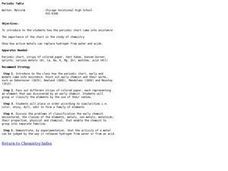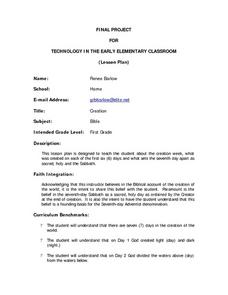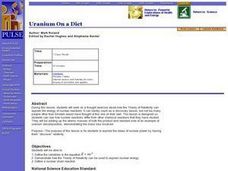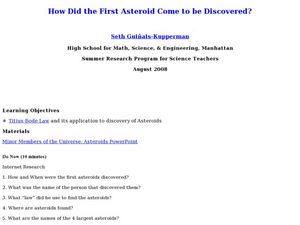Curated OER
Periodic Table
Students identify the periodic table trends and predict material properties. They also design and conduct simple experiments and test material properties. Finally, students compare and contrast material properties and that chemical...
Curated OER
The Great Hubble
Students explain how Hubble telescope captures images from space. In this space science lesson, students use the internet to view space photos. They debate on an issue raised by the teacher.
Curated OER
The Planet Earth
Students explore the planet Earth, outer space, and Earth's axis. They demonstrate reading comprehension skills, including literal meaning, inference and critical analysis.
Curated OER
Trees!
Students are introduced to the parts of trees through discussion and participation in learning centers with hands on activities that focus on each part.
Curated OER
The Future of the Milky Way
Students brainstorm ideas about the future of our galaxy. In this space science lesson, students research the three main events happening in the Milky Way. They write a report about their findings.
Curated OER
Space - In Your Face or Not?
Second graders, in groups, examine how it doesn't matter if they can see the planets in the solar system or not--they're there.
Curated OER
WEAVING TECHNOLOGY INTO THEMATIC UNITS
Fourth graders explore the planets by researching and writing a report about one of the nine planets.
Curated OER
Constructing a Spectroscope
Students construct a simple spectroscope. They observe the emission spectrum produce by a source of light.
Curated OER
Perception And The Interpretation of Experiences
Students describe a problem and propose alternative strategies for the solution. They use a model or drawing to visualize the solution to a problem. Students identify alternative factors to be considered when examining possible...
Curated OER
Hang a Million
Students hang 200 sheets of paper, each with 5000 X's, around the classroom. When completed, this gives them a concrete example of 1,000,000 which will be useful in getting a feel for the lengths of time involved in evolution.
Curated OER
Technology In The Early Elementary Classroom
First graders explore the creation of the world and what was created on each specific day. They read the creation of the world from the Bible, watch a video, and sing a song about the Creator. Using Kid Pix software, 1st graders create...
Curated OER
Uranium On a Diet
Students examine how nuclear reactions differ from other chemical reactions they have studied. They add up atomic masses of both the product and reactant side of an example of uranium decomposition, demonstrating mass loss involved.
Curated OER
Is It Lunar or Lunacy?
Sixth graders are introduced to the moon and its phases. Individually, they draw a sketch of each phase of the moon and read a short article about Galileo. To end the activity, they examine the difference between refracting and...
Curated OER
Satellite Mobiles
Students discuss satellites and their functions. They design and construct their own satellite out of readily available materials. Students are taught the definition of a satellite. They discuss the two main purposes of satellites:...
Curated OER
How Did the First Asteroid Come to be Discovered?
Learners examine asteroids including how and when they were discovered. In this asteroid lesson students view a PowerPoint presentation on asteroids.
Curated OER
Astronomical Scales
Students describe the different units of measurement. In this space science lesson, students calculate astronomical distances using a scale. They explain the significance of using scientific notation in expressing very small or very...
Other popular searches
- Sun and Stars Diagram
- The Sun and Stars
- Moon, Sun and Stars
- Sun and Stars Powerpoint
- Moon Sun and Stars
- Sun and Stars Webquest
- Sun and Stars Web Quest
- Stars and Sun
- Sun Moon and Stars Activity
- Identifying Sun Moon Stars

















